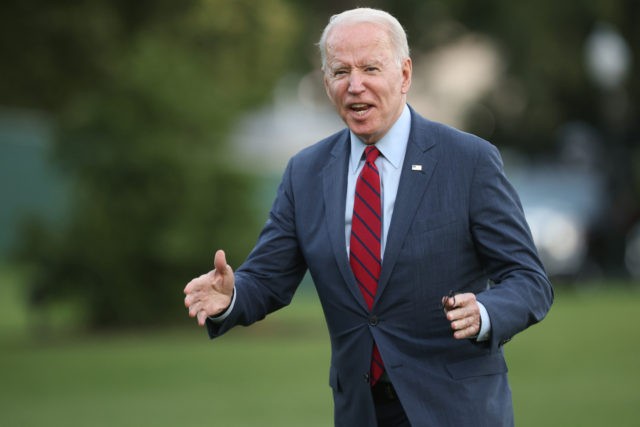Stephen Moore: Brace Yourself for the Return of the Corporate Welfare State
 By Stephen Moore | June 28, 2021 | 5:04pm EDT
By Stephen Moore | June 28, 2021 | 5:04pm EDT
No one is paying much attention, but Washington is building up a vast new multitrillion-dollar welfare class: corporate America.
Deep inside President Joe Biden's budget are hundreds of billions of dollars of loans, grants, and loan guarantees for corporate America. This Aid to Dependent Corporations is most prevalent in the area of renewable energy. Despite more than $100 billion ALREADY doled out to wind and solar companies over the past 30 years, the Biden plan would enrich often-very wealthy investors in solar and wind plants with another $100 to $200 billion in the president's green energy scheme.
For the past dozen years, we keep hearing how much cheaper and more efficient the wind and solar industries are becoming, and yet the subsidies keep getting more expensive and long-lasting. Explain that one.
Then there is another stash of tens of billions of taxpayer dollars for companies such as Tesla and Ford so they can make electric cars. The government will also spend billions for road recharging stations. Wait a minute. I don't recall Uncle Sam paying to build gas stations across the country.
These are mostly Democratic initiatives, but Republicans are in on the gambit. In early June, the Senate passed by a 68-32 margin what CNBC has called "one of the largest (bipartisan) industrial bills in U.S. history."
The idea is to shower money on manufacturers, semiconductor makers, tech companies, and the military industrial complex to allow America to compete more effectively with China. The bill's price tag is $250 billion.
Congress and the White House actually believe that politicians and government agencies can do a better job of allocating capital than our multitrillion-dollar financial markets and venture capital firms.
Brian Deese, the chief economist for the Biden White House, recently explained the rationale for erecting this new corporate welfare state: "The idea of an open, free-market global economy ignores the reality that China and other countries are playing by a different set of rules. Strategic public investment (corporate welfare) to shelter and grow champion industries is a reality of the 21st-century economy."
That is a dangerous absurdity. If you believe this, you believe that Al Gore invented the Internet. And what has the government "invested" in over the last 20 years that has had a positive return? The New York subway system?
Back in the 1970s, there was a big scare that Japan's industrial policy, the Ministry of International Trade and Industry, would overtake America's technological prowess. Liberals said we should imitate the hands-on policies of the Land of the Rising Sun. Instead, Ronald Reagan was elected and cut investment taxes and government spending, and since then, the U.S. stock market has risen three times faster than Japan's. It was almost all private sector-driven, with tens of trillions of dollars of wealth created by the revolution in innovation in places such as Silicon Valley.
The last big government venture to "partner" with private industry happened in the Obama years, when his trillion-dollar stimulus plan of 2009 wasted tens of billions of dollars on more than a dozen now-bankrupt companies such as Solyndra.
The quest to keep America dominant in 21st-century industries in robotics, bioengineering, manufacturing, 5G technologies, 3D imaging, artificial intelligence, fracking technologies, micronuclear power plants, and so on is an honorable one. But inventions and innovations almost never come from government; when they do, they often send companies on wild-goose chases as they hunt down "free" government dollars instead of selling private investment capitalists on their business models. Operation Warp Speed wasn't so much a government-directed program as a deregulation to get a vaccine in people's arms in record time.
If we want more investment, what is the logic of the Biden plan to raise taxes on private investment capital — through higher personal income, capital gains, and dividend and corporate tax rates? These will drain funding for private ventures and make investments in U.S. companies less attractive in after-tax returns relative to investing in other countries — such as China.
Dumbest of all is that while Congress ladles out trillions of dollars into new corporate welfare programs, we now have bipartisan bills to break up "monopolistic" Big Tech companies, including Amazon, Apple, Facebook, and Google. These firms have market capitalization of more than $6 trillion, employ hundreds of thousands of American workers, and arguably do more to spur American innovation than all the government programs in the history of the United States.
Deese is dead wrong. China and its communistic economic system will not outcompete the United States in the 21st century unless we are dumb enough to tax our own successful companies, break them up if they are "too successful," and destroy our domestic energy industry. If politicians decide where investment dollars are going, we will soon be paying for hundreds of bankrupt Solyndras and our tech leadership really will be in mortal peril. Washington is a much greater threat to American supremacy right now than China.
Stephen Moore is a senior fellow at the Heritage Foundation and an economic consultant with FreedomWorks. He is the co-author of "Trumponomics: Inside the America First Plan to Revive the American Economy."
Dallas Fed Records Blisteringly Hot Inflation in June

Temperatures are cool right now in Dallas but inflation is running red hot.
Higher prices for raw materials were reported by 81.5 percent of manufacturers surveyed by the Federal Reserve Bank of Dallas in June. No change in prices was reported by 17.8 percent. Just 0.7 percent said they paid less for raw materials.
That brought the Dallas Fed’s index for raw materials up from 79.9 in May to 80.8, the highest reading in records that go back to 2004. Prior to the most recent report, May was the highest reading on record since October 2004. The average score is 25.4.
“Inflation is real and here now,” an executive in metal manufacturing told the Dalls Fed. “We have raised all wages twice this year. Starting wages rose in March and June, each time by a dollar. We have raised prices twice, once in spring and once now.”
Higher prices for finished goods were reported by 44.6 percent of manufacturers. Lower prices were reported by 1.8 percent and 53.6 percent reported no change.
The finished goods index rose to 42.8 percent, up from 38.4 percent in May. That is also a record high in a series that averages 6.7. This was the third straight month of record highs. Prior to April, the record high was 35.5 in November 2005.
“Raw material pricing has more than doubled from 2020, if you can get materials,” a machinery manufacturing executive said.
The wage index rose to 48.1 percent, up 9.1 points from May. This is the third consecutive record high for wages. Prior to April the record was 36.7 in January of 2007.
The forward-looking component of the survey, which asks manufacturers about business conditions six months from now, also showed very high prices and wage pressures. The index for raw materials prices six months from now fell 8.,5 points to 53.6. The index for finished goods prices rose 5.2 points to 53.6, the highest since July 2008 record of 57.8. The wages and benefits index climbed 2.8 points to 59.2, the highest since the June 2004 record high of 60.1.
The share of Texas businesses saying they are experiencing supply chain disruptions jumped to 61.0 percent, up to 35.5 percent in February. Of those experiencing supply chain disruptions, forty-one percent said supply chain problems had grown somewhat worse in the last month and 18.8 percent said they had become significantly worse.
“I would have thought the supply-chain issue would have corrected by now or at least shown improvement, but that does not seem to be the case. I think [it’s] due to labor shortages and the lack of availability of containers,” a wholesale merchant of durable goods told the Dallas Fed.
Businesses are also having trouble hiring enough workers. The share saying they are attempting to hire hit 60.3 percent in June. A lack of applicants was cited by 70.4 of those hiring, with 47.3 blaming high unemployment benefits, 42.5 percent saying competitors had bid away workers with higher pay, and 37.2 percent saying they couldn’t find workers with the right technical skills.
“Unemployment is more than we usually offer as pay. So why work?” one retailer commented.
“Politicians created this employment shortage under the disguise of COVID relief payments; they should have ended six months ago!” a business owner in rental services said.
“Until the general workforce is forced to work to make a living, my company and all others are going to have problems. We continually hear that it is much easier to stay home and draw generous unemployment benefits than it is to work. This is very discouraging for employers and conflicts with what I think is the true ‘American way,'” a paper company executive said.
Poll: Majority of Young Adults Have Positive View of Socialism

An Axios and Momentive poll found that a majority of young adults, people ages 18-24, in the United States have a positive view of socialism.
Fifty-two percent of Gen Z respondents said they have a positive view of socialism.
Overall, 41 percent of Americans said they have a positive view of socialism, with a majority (52 percent) saying they have a negative view.
The poll noted a very flight difference in the poll from 2019 when 55 percent of the respondents said they have a positive view of socialism.
The Hill noted these findings come as Republicans are constantly labeling Democrats and the Democrat party as radicals with a socialist agenda.
The poll also found 54 percent of the young adults have a negative view of capitalism, compared to the 42 percent who said they have a positive view of capitalism.
Additionally, when asked about the bigger problem in this country, 58 percent said it is the “unfairness in the economic system that favors the wealthy,” and 36 percent said it is the “over-regulation of the free market that interferes with growth and prosperity.”
The Axios and Momentive poll was conducted through SurveyMonkey online between June 11 to 15. The online poll interviewed a national sample size of 2,309 adults.
The poll data was weighted for age, race, sex, education, and geography by using the Census Bureau’s American Community Survey to reflect the United States’ demographic composition.
No comments:
Post a Comment